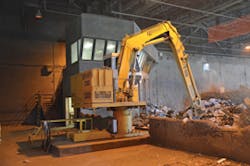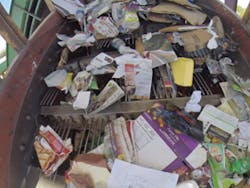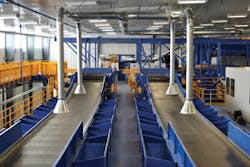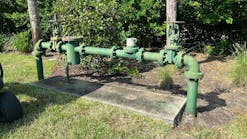The variations in MRFs-the material streams, the technology utilized to process them and the people employed to operate the technologies-are too broad to claim there is a “typical” MRF in North America.
Thus, MRFs fit into one of three categories: beginner, intermediate, and large. The type of technology employed in each operation determines how many employees are needed (some operations use local inmates to do the work).
When it comes to variety in MRFs, the operations of Republic Services are a case in point. Mark Henke is in charge of several Republic Services MRF operations throughout the central region, which includes 15 facilities in an area encompassing Oklahoma to Minnesota to Ohio to Arkansas. In one locale, the property and equipment are owned by a county and Republic Services operates it. All of the others are owned and operated by Republic Services, which operates 80 MRFs total.
There isn’t a typical facility, given the variations in the characteristics of materials processed and the technology and components needed to process them, says Henke.
“We have facilities where we do very minimal processing. Material comes in from the source that generated the material extremely clean where it is separated as it comes in the door, so we bale it as we receive it,” he says.
Some facilities have a basic presort on the processing side with minimal separation before the material is baled.
Other facilities are more complex and involve residential or commercial single-stream collection.
“They include a wide variety of various materials and the processing equipment as well as the sorting staff that does the complete separation and quality control,” Henke points out. “In general terms, the recovery equipment separates the materials, and the sorting staff creates the quality.”
Operations would include such technology as a drum feed unit and presort to collect items that should not go downstream: larger plastic, for example, or bulk metal.
Typically, the first component is the OCC screen, which strips off the large pieces of cardboard and everything going beyond that is paper and containers. A small scalping screen then removes some of the very small material. Glass collection then begins.
“Depending on the volume you’re processing, your screens determine your throughput,” says Henke. “Screens have evolved over the last several years, going from 96-inch wide to 132-inch wide and now there are some as far as 144-inch wide.”
A rod deck sifts out the paper content of commingled waste.
Contact time means more volume, and more volume means more throughputs per hour, he points out.
“That’s what separates the paper and the containers,” he says. “Anything that goes over the screen goes to a quality control line where sorters do the last step in removing any nonpaper products. Materials that go beyond the screens should be the containers and can go through a manual sort line or a very-high-technology sort line, including optical sorters.”
A screen package depends on the types of materials being brought into the MRF.
“If you’re going to do residential material as well as commercial material, there’s a selection of equipment that would be influenced by that,” says Henke. “We have a few facilities where on one shift they would process residential material-common materials that residents would put out for recycling as traditional commodities-and then the second shift would process commercial material from businesses, such as paper, cardboard, and some containers.”
In choosing a screen package, Republic Services considers the direction of the growth in the region it operates: residential single stream, for example, or commercial single stream, or both. “If we are developing an area, we try to determine the growth towards commercial material, or whether there is there an opportunity where we can grow more residential material through contracts with municipalities,” Henke says. Container lines have become more sophisticated with the use of optical units, he adds.
“Typically, there would be an opportunity to use a type of scalping screen in which you can have separation of the containers,” he says. “There are different ways you can put together the container line: You can try to do plastics first or take a cut and do aluminum. Knowing the characteristics of the stream will help determine how you put your system together.”
In targeting PET, HDPE, or No. 3 through No. 7, optical units have improved to the point where 95% to 98% of all available material can be captured, and of that capture, it will be 98% pure, says Henke.
One caveat to achieve the best opportunity of such high-capture percentages: “You’ve taken a good cut of your paper and containers and have done a good job with separation at that point,” he says. “There is not a lot of collateral material on the lines-such as a piece of paper with a PET bottle. Through the speed adjustment of the optical unit acceleration belt, you can spread the material across the belt for a better introduction to the optical recovery capabilities. This, in turn, prevents collateral hits during the recovery process.”
In capturing aluminum, eddy currents have always been regarded as a valuable piece of equipment within the recycling line, Henke says.
“Some of the latest technology is in how they space the magnets inside the units, and, therefore, the recovery is much higher,” he adds.
The sophistication of equipment will determine the number of employees needed to run a MRF operation.
“On a typical stream for residential material, you would probably need a minimum of five people, if not more, on the line just to collect the available PET, and you’d need the same in terms of collecting all of the HDPE or even No. 3 through No. 7,” Henke says. “Each optical unit does the job of several sorters and has a higher degree of recovery and probably a cleaner degree of recovery. Sorters are still required after each optical unit to ensure the quality and to remove any items that might have been a collateral hit.
Containers and paper that have been separated by newspaper screeners then meet the angled
sorters, designed to help further separate paper from containers.
“Generally, on a typical 25-ton-an-hour system, you would require somewhere between 18 and 22 sorters,” he adds. “On a 35-ton-an-hour system, you’re looking at 26 to 30 sorters, and that’s if you have optical units that are taking care of the PETs, the HDPE, and the No. 3 through No. 7.”
MRF operations collecting aseptic cartons can use similar optical units.
“There are different ways to collect that,” says Henke. “You can do it by hand. You would need an extra person for that.”
Henke describes drum feeds as being akin to a box with a conveyer on the bottom and it feeds slowly to a metering wheel, with the material going underneath as well as over the top.
“It gives it an even, fluid flow of material without a lot of highs and lows within the system,” he says. “It gives the presort an opportunity to see what they can pull off, and the initial screens are not overwhelmed.”
The metering bin can be filled up, offering 10 to 15 minutes of time before it needs to be recharged again, allowing employees time to tend to other tasks as well as feed the line, Henke points out.
Typically, in a residential line, there are one or two newspaper screens and a “polishing” or final finishing screen to separate a lot of the smaller pieces of paper that are still on the line from the containers, offering a yield of a mixed paper-type volume.
SCADA is another technology creating more efficiency in MRF operations.
“It’s a data collection program that’s internal to the operating software of the recovery equipment,” says Henke. “If you have an in-line scale, you can instantaneously record the volume you are processing. You can incorporate the number of sorters you have on the line. You can even incorporate a cost per hour for those sorters.
“From the time you start the line to the time you finish, you can record any hours of labor associated with that time. You can implement the schedule so it knows the difference between a break and a lunch at the end of the day as opposed to downtime.”
SCADA equipment also has a built-in downtime management program that helps identify the problems experienced throughout the week or month.
“It’s very important knowing what’s causing your downtime so you can hone in on the top reasons you’re going down, correct them, and increase your uptime,” says Henke. “Anytime you can increase your uptime, you increase your efficiencies and your overall costs are influenced by that.”
Changes in SCADA packages now feature a touchscreen, enabling the user to make immediate changes to the program.
“If I want to adjust a conveyor that has variable speed capabilities, I would be able to do that at the screen and immediately influence the recovery process,” says Henke. “Same thing with the angles and the speeds of the screens. I can make changes as I see characteristics change on the in-bound volume. If the panel is centrally located, I can monitor each change immediately by looking at how the material is coming across the screens through my adjustment. I can also then monitor if any change I made influenced anything on the container line-the two have to be balanced.”
In its equipment choices, Republic Services utilizes several different vendors nationwide.
“We typically do not mix and match vendors within a system,” Henke says. “They would answer one of our RFPs for a typical recycling center to supply the recovery equipment. We would then choose not only the best design, but the best design that fits that footprint and will accomplish the goals of that particular location.”
While price is a consideration, “it is not always the number-one reason we choose a particular design or a particular company,” Henke says. “We look at the technology package they’re proposing. We look at how the technology meets the characteristics of what we plan on introducing as the in-bound stream. We also look at how this package is going to benefit us in the future.”
Looking ahead, an operation has to predict whether it’s heading more toward commercial, or residential, or both types of collections, and plan accordingly.
“Once we decide that we do go with a second phase and add on equipment, we consider where we would add this equipment, how would we process in the interim, how long would the process of the expansion take? All of this goes into the planning stage and the selection process for a new system.”
One need only to consider how the wastestream has changed in the past few years to know that MRF managers always need to keep an ear to the ground.
As information has become more readily available over electronic devices, Henke has noticed a decline in the newspaper and magazine stream.
“We design these facilities today for a current volume of paper and container separation and over the last 10 years, we’ve seen a decline in the available newspaper content of the stream,” he points out. “Five to 10 years ago, in the typical residential single stream we would see somewhere between 50 and 60 percent newspaper in the overall mix. Today, I’m guessing an average would be 35 to 40 percent of the overall mix.”
The MRF operation will still have to install screening packages but concentrate on more containers, Henke says.
“As the paper percentage goes down, the containers still remain the same, but their overall percentage of what we were processing per hour actually grows,” he says.
The changing nature of plastic materials also is affecting MRFs, Henke points out.
“If you look at a PET bottle today, it is much thinner in composition than it was five or 10 years ago,” he says. “An older PET bottle coming through the system has more of a propensity to retain its shape and is more easily recovered than a bottle today.
“Look at a water bottle today, for example. It is so thin, it’s easily crushed. And when it’s crushed, it does not retain its shape. It has a tendency to act more like a two-dimensional piece of paper than a bottle.”
In an ideal situation, the bottle rolls off of the screens and is collected. “But many times, those flattened PET bottles ride up the screen with the paper because they act more like a piece of paper,” Henke points out. “That’s another characteristic that changes over time. We will always have QC sorters on the line, especially the paper line.”
While the technology of the system recovery equipment completes the separation, “it’s truly the sorting staff that provides the high quality,” Henke says. “For example, they are the ones who pull off anything that is not fiber, such as plastic bottles and aluminum cans.”
Another factor that can take a MRF by surprise is weather, as evidenced by the harsh winter experienced this past year by many in the Northeast and Midwest.
“One of the characteristics you’re constantly battling is ice and snow intermingling with the recycling material,” says Henke. “When that happens, it becomes wet and bogs down a little bit. Throughput decreases in extremely cold weather, and the cold and wet materials affect throughput and quality.”
Case in point: Cardboard can enter the stream extremely wet and not as stiff as in good weather. As it goes across the screen as a more pliable material, it falls through the OCC screen rather than riding on top.
That may necessitate additional labor to manually separate the material.
“With a lot of ice and snow, sometimes you have to run your equipment longer in the day just to make sure you decrease the possibility of it freezing up for the next day,” Henke says.
“You do a lot more maintenance because of the buildup of ice and snow, especially with drum feeders. There are steel belts inside, and they’re typically on the tip floor, and when they’re subjected to the very cold weather they have a tendency to freeze up. Once those are frozen, they are very difficult to get back rolling again.”
When it comes to whether or not there is a typical MRF, “it’s really more sizing in terms of system throughput rather than being beginning, intermediate, or full scale,” says Terry Schneider, president and COO of CP Manufacturing. “Our McMRF, a 10-ton-an-hour single-stream sort system, would be considered a small system. A medium system would be in the 20- to 25-tons-per-hour range, and large systems are 35 tons and more. Two 35-tons-per-hour systems incorporated creates a 70-tons-per-hour system.”
CP Manufacturing has a 35-tons-per-hour system in service at Republic Services’ Lorain County operation in Oberlin, OH.
Republic Services’ Oberlin operation also has a SCADA package that enables the facility to control the system and recognize throughput, run time, event tracking, motor efficiency, bale counts, and downtime, Schneider says.
“The easy-to-read dashboard allows plant operations and maintenance management increased visibility of what is happening in the MRF at all times in the day,” he adds.
CP Manufacturing has a scale on the presort line that constantly measures the volume of material entering the plant, Schneider says.
“They can control the input based on the material stream weight,” he adds. “If they’re constantly loading at the same speed, the operators will recognize system fluctuations and adjust accordingly. Knowing the input weight allows them to make adjustments to the system based on the bulk density of that days’ material.”
In starting a MRF, the management team needs to understand the inbound material and the commodity markets to which they plan to ship, Schneider says.
“Understanding the characterization of the inbound material will allow the operator and the equipment manufacturer to design a system to meet the operators’ needs,” he says. “A Midwestern-based operation will probably be shipping its commodities to domestic markets. Domestic markets may have different tolerance levels than an operator on the East or West coast that could ship commodities to foreign markets.”
The more information a single-stream operator can give an equipment manufacturer regarding the inbound and outbound material characteristic, “the better we can help them design the system to meet their goals,” Schneider says.
Schneider points out that it takes time for a MRF management team to understand where the sorters are ideally stationed and what their primary and secondary sorting functions will be.
There is a learning curve of about two to three months for the management team and employees of a new facility to understand the material streams they are receiving and to arrive at the ideal operating plan, he says.
“Each day the material stream changes a bit,” Schneider says. “The Monday route may be from a neighborhood generating more recyclables and the Tuesday route may be from another part of town with fewer recyclables and higher residue content. The material characterization will be different each of those days.”
As the MRF management team begins to understand their day-to-day material stream, they can structure their operating plan, he says.
Optical sorters are the most significant technology in MRFs today to replace manual sorters, Schneider says.
“When you use optics like the MSS optical units, the machine recognizes materials such as various plastics in the stream,” he says. “Management can replace sorters with the optical unit because it automatically ejects the commodity. In a large system like a 35-tons-per-hour system, an optical unit ejecting PET could save six to eight manual sorters on that commodity alone.”
At Republic Services’ operation in Oberlin, there’s an optical sorter ejecting PET and there’s one employee responsible for Quality Control on that material stream, Schneider says, adding that “it reduces the labor significantly.”
That also raises the bar on the type of employee suited for the job, with sorters being trained for quality control rather than picking a specific commodity, he says.
“You have more technologically advanced equipment, so you need maintenance personnel who are trained to make repairs on that higher technology equipment,” Schneider points out.
In the Oberlin operation, there are three MSS optical sorters firing on HDPE, PET, cartons and No. 3 through No. 7 plastics. There are quality control sorters on each ejected commodity, compared with having 15 to 20 employees to capture the same volume of commodities, he says.
As for the move toward zero waste, energy production from contaminated commodities will be the future, Schneider says.
Small shredded pieces of paper, plastic bottle caps and other high-Btu materials can be used as a fuel source for a gasification system or a cement kiln, Schneider says.
“There are technologies out there to use the residue coming off of the back end of a MRF as a fuel source to create energy,” he adds. “That’s the direction of future technology and where the systems are going.”
Waste Management has 148 material recovery facilities, including facilities that process traditional recyclables, construction-and-demolition debris, and e-waste. Of this total, 50 have been designed specifically to process material collection from single-stream recycling programs.
“MRFs come in all shapes and sizes, from small rural recycling centers to very large facilities processing more than 200,000 tons of material each year,” says Jennifer Andrews, Waste Management spokesperson. “Single-stream MRFs are generally the largest because the cost of the technology requires large volumes of material to support the equipment investments.”
Depending on the size, number of shifts, and facility throughput/complexity, the number of employees in a MRF can vary from several to more than 100, Andrews says.
“MRF operations are evolving as the technology and the types of materials processed evolve and become more complex,” she says. “We invest in technology to separate by size, shape, composition, and density to get as much material as we can: paper magnets, star screens, optical sorting equipment, magnets, and eddy currents all help to create separation of material into different types and grades. While technology helps with many of the basic separation functions, there are limits to what we can expect equipment to do.”
Technology cannot identify the wide variety of contaminants that Waste Management employees see coming into their facilities, Andrews adds.
“We have to hand-sort out bags of garbage, hoses, bowling balls, bottles with liquid in them,” she says. “We have had to add more labor to sort out contamination. This also includes the variety of nonrecyclable plastics that equipment can’t identify. So a lot of our labor at facilities is focused on sorting out material that should not be there in the first place or that ends up in the wrong place on the line while we use equipment to sort the basic grades of material.”
Waste Management uses a series of sizing screens and labor to sort various grades of paper-newspaper versus mixed waste paper, Andrews says, adding that labor is used for quality control after each mechanical sort.
Rumpke operates 11 recycling facilities, including buy-backs and larger regional MRFs in Cincinnati and Columbus, OH.
“Our Columbus and Cincinnati MRFs are state-of-the-art facilities,” says Amanda Pratt, director of communications for Rumpke.
Rumpke’s recycling team visited nine MRFs in California, Rhode Island, and Canada before deciding on the design and equipment to utilize for its $32 million Rumpke Recycling Cincinnati facility, which opened in November 2013 and processes more than 55 tons of residential and commercial material an hour with a total of up to 15,000 tons of recycling processed monthly. The 100,000-square-foot facility serves a population of 4.5 million.
The Rumpke MRFs feature Machinex technology and includes hand sorting, disc screeners, optical scanning equipment, an electromagnet for ferrous scrap separation, and two eddy-current separators for aluminum-all technology common to large MRFs.
The presort conveyors operate at speeds of up to 320 feet per minute. The six optical scanner conveyors’ total speed is up to 600 feet per minute. The facility also has the ability to accept carton and aseptic containers.
Rumpke’s Cincinnati MRF features a public education center with tour platform.
The process at Rumpke Recycling Cincinnati begins with material that is weighed and unloaded onto a 15,000-square-foot tipping floor with enough capacity to hold 2.5 million pounds.
It is then loaded onto one of two drum feeders that spread out and regulate the amount of material entering the plant, enabling employees and equipment to efficiently sort the material.
Material enters the plant at the presort station, where a team of 12 employees removes that which cannot be processed or recycled. Following the presort, the recyclables travel through the cardboard screener, three decks of large spinning discs allowing cardboard to travel over top of the discs while other material falls below.
The materials next pass through the scalping screen, which breaks glass bottles and allows them and other small recyclables to fall to a deck below for additional sorting, while paper and other containers ride over the screens.
The material then encounters five newspaper screeners designed to remove newspaper from the recycling mix. Spinning discs allow the paper to ride over the top while other recyclables fall below.
The containers and paper that were separated by the newspaper screeners then meet the angled sorters, designed to help further separate paper from containers. Fans blow the material and assist the paper in its travels over the top of the machine while containers roll off the side.
Next, the material travels over the top of the angled sorters’ three optical scanners, designed to further remove paper from containers. Recyclables then go on to an overhead magnet, which attracts and removes steel cans from the recycling mix.
Recyclables then meet the fourth optical scanner, which identifies No. 2 plastic bottles. It then travels through the eddy current, which removes aluminum cans. Recyclables then go through two more optical scanners to remove No. 1 plastic as well as mixed plastic bottles and cartons.
Materials are separated by type and compacted into bales weighing 800 to 1,200 pounds each. The materials are then shipped to manufacturers who use the raw materials to make new products.
“Rumpke also operates a one-of-kind glass processing facility in Dayton, OH,” Pratt points out. “Therefore, our facilities in Columbus and Cincinnati both have systems to break and clean up mixed glass before it is shipped to our Dayton facility.”
The number of employees required for each operation in the MRF depends on its size, volume of material, and the type of equipment inside, Pratt says.
“Personnel are needed for sorting, quality control, maintenance, baling, and shipping,” she says. “For example, our Cincinnati MRF employs slightly more than 100 on the processing side only. We also have a collection and hauling division for recycling.”
Technology has improved efficiency and overall processing speed, Pratt points out.
“It has improved processing quality as well,” she adds. “It has shifted the types of jobs available. There may be less manual sorting and less temp labor based on seasonal volumes and more permanent positions.”
The MRF operations in Red Wing, MN, take in 20,000 to 22,000 tons of material a day.
“We operate our dirty MRF about seven hours a day with processing materials, and the capacity is 15 to 20 tons an hour,” says Jeff Schneider, deputy director of public works for Red Wing. “We also have a clean MRF that is built in to the dirty MRF that we are able to put our source-separated recyclables through. We switch off from doing dirty MRF work to clean MRF work.”
Recently, Red Wing started accepting single-sort materials from haulers outside of the community who find it more economical to haul to its facility in contrast to driving to the MRF for Minnesota’s Twin Cities area.
Red Wing’s MRF uses manual separation for an initial floor inspection of loads where workers remove large pieces of steel and any cordage that get wrapped or tangled downstream.
“We’ll take out cardboard, steel, and electronics if they’re visible,” says Schneider. “It’s a very simple operation where we place the material onto an import conveyor with a skid-steer, and the material travels over that and goes up the incline to get to an elevation where it goes past another pick station where they’re removing additional commodities and oversized bulk materials.”
The material then goes through a trommel with 6-inch holes to remove beverage and food containers and 2-inch holes to remove fines.
The pick station is staffed with inmates from the Minnesota Correctional Facility-Red Wing.
“These individuals are close to the end of their sentence, so it’s integrating these people back into work,” says Schneider. “We provide extensive training to these individuals in terms of fork lift certification, skid-steer training, and aerial lift training, and we allow them to operate our baling operations and many others. We treat them as we would our staff and give them training, so when they are released, they have some skills they can utilize.”
When adding equipment to a MRF, Schneider’s advice is to ask vendors to bring different models to the facility and put waste through them as well as tour as many facilities as possible to get an idea of what might work.
David Selover, equipment sales engineer for Andela Products, says single-stream is the best way to describe a typical MRF these days.
“The material arrives to the MRF from residents in a single stream of commingled materials such as paper, cardboard, organics, glass, and most other permitted refuse,” he says. “A MRF has specialized machinery to sort these jumbled materials into their respective categories so that ideally they can be recycled. Certain categories, such as organics, are typically landfilled.”
Yet, separating the materials presents design and machinery challenges for MRF builders worldwide, Selover says.
“Sizes range significantly from small to large operations, dependent on an area’s need to service a population base,” he says. “In my travels, I would describe 25 employees as a small- to medium-size operation, with 250 employees as a larger company that may have five locations or so. Larger operations beyond that certainly do exist. Some small Andela systems operate with only a few people.”
Andela Products specializes in the separation of glass from other single-stream materials typically as one of the last steps in the process of material recovery, depending on the MRF’s overall design.
Selective reduction is the main principle behind Andela technology, enabling the glass to be reduced while the other materials remain intact so that the glass can then be screened away from the other contaminants, says Selover.
The separated glass is then a usable “unwashed aggregate” for a variety of beneficial uses such as landscape media, general construction sands and gravels, drainage products, backfill, road base, and road bedding, among other uses.
“Different areas of the world find success in best available local end markets for the glass,” notes Selover.
One operation in which Andela technology is being used is in Dare County, NC, where Carl Walker, recycling coordinator, describes the operation as “low-tech.”
There are 10 recycle centers, including trailers, spread throughout sites countywide. Four days a week, the Dare County Solid Waste and Recycling operation picks up plastics, cardboard, paper, aluminum, and steel cans from some 200 businesses.
The hub of the operations is in Manteo, NC, where haulers and members of the public bring in items to recycle. Two contractors in the county do house-to-house collections.
Walker says Dare County endeavors to make money from recyclables, which necessitates separating the aluminum, cardboard, paper, and the steel cans. Ten county employees staff the operation, which is augmented by 25 to 30 inmates who are paid $1 a day each to bale cardboard and aluminum and steel cans. In the winter, the inmates work three days a week; in the spring and summer, that increases to five days.
“From here, we ship everything out to the markets,” says Walker. “I have a market for everything. I have one for paper, one for steel cans, one for aluminum cans, plastics, batteries, and electronics that come in here. Even the brush that comes in here, we take to the landfill and grind it up, and it turns into some real beautiful mulch that we hand out to the residents. If someone cuts the trunk of a tree into about 12 or 13 inches, we bring that in, split it up, and give it away for free firewood.”
The glass and plastic is commingled; the glass is crushed onsite with a system from Andela Products. In 2013, between 800 and 900 tons of glass were crushed.
The crushed glass is given away to residents, who use it for roadbeds, flowerbeds, and crafts. Walker notes that as soon as it’s crushed, it’s gone within two days.
“It’s a very good system,” Walker says of the Andela Products glass crushing equipment. “We’re really happy with it.”
The Andela Products glass crusher is the only technology Dare County uses in its operation, Walker says. Trucks are borrowed from other departments, and the bus used to pick up the inmates was purchased for $1 from the school district.
“I don’t spend a lot of money on equipment,” says Walker. “We try to get by on what we have.”
Walker advises that a small operation just starting a MRF for the first time should start off “low.”
“We take trucks from other departments, like sanitation, that we use to dump at our recycle centers,” he says. “We use 8-yard Dumpsters. Try to get equipment that’s been handed down and try to take care of it. Try not to run it too hard, and you can get by with it.”
In Germany, where the Stadler company is based, labor is much more expensive than in the US, points out Gerban Nijland, vice president of sales for Stadler America.
As such, the company, which designs and installs advanced recycling and sorting technology, designs systems with minimal manual labor requirements, he adds.
Carried and serviced by Zimmer America, Stadler manufactures tailor-made MRFs for industrial waste, sorting of lightweight packaging materials and polymers, sorting for commingled material, MSW, paper, old corrugated cardboard, and ballistic separation.
Stadler MRFs handle throughputs from a few tons per hour up to 90 tons per hour.
“The conventional ways of sorting waste in the US depend on a larger number of manual sorters,” points out Nijland, adding that a Stadler MRF is designed to utilize a smaller number of manual sorters. That design centers on the efficiency of the ballistic separator.
“The two-dimensional flat material gets further sorted with optical sorting equipment,” Nijland says. “After this step, only a manual quality control needs to be provided. The process leads to a much better material purity without all the manual sorting labor that has been necessary before.”
The sorting of three-dimensional rolling material also can be done more efficiently, says Nijland, adding that its design depends on such customer requirements as material flow and composition.
“Depending on the different plastic materials to be selected and sorted, the number of people doing the manual quality control is determined,” Nijland adds. “However, the more automated a sorting line is—and the better the machine performance is—the less manual sorters are necessary. That means we are shifting towards manual quality control instead of manual sorting, with fewer personnel needed.”
Traditionally, MRF design has focused on such rotary-style equipment as trommels or disc and OCC screens, says Dick Reeves, industry sales manager for resource recovery for General Kinematics.
General Kinematics provides vibratory equipment.
“The advantage of the vibratory is that you don’t have the rotary equipment that comes in direct contact with the material stream, thereby reducing the amount of maintenance time, the disc wrapping, and the wear and tear associated with rotary equipment,” says Reeves.
Vibratory equipment from General Kinematics is designed to short-circuit the hours of maintenance for such tasks as cutting loose plastic that may be wrapped and trapped around equipment, he adds.
“The vibratory motion provides separation of size, and although it’s not perfect, it’s much easier to clean and maintain, either from alongside on the deck while the unit is running or during breaks and cleanup,” Reeves says. “It’s a much safer environment to work on.”
Daily maintenance can be simple, as it may take two employees to walk through with a rake and clean off the material, depending on the capacity the operation is running, Reeves says.
While General Kinematics equipment is used primarily for C&D waste, the company also has a history with commingled and MSW, Reeves notes. The company has an installation processing single stream at Marpan in Tallahassee, FL, that uses a new style of rod deck the company has developed.
“We’re also introducing new technology through a long stroke conveyor which is twice the current displacement seen on conveyors that we think is going to be a much-improved scenario for the industry,” Reeves says.
General Kinematics systems have been well suited in smaller venues with processing rates of 5 to 10 tons per hour, many of which are just starting to consider a recycling program, Reeves says. The technology and expertise in developing vibratory equipment makes General Kinematics screens, separators, and more the heart of any sorting system, Reeves says.
There are many ways to run a MRF. Some municipalities may own the equipment, but have a private contractor run it. Such was the case in Oxnard, CA, where Republic operated its MRF until the city recently took over, using zero waste as its blueprint for operations.
Oxnard’s blueprint for doing so is a zero-waste goal. “We want to do better in getting our residents to understand what we all have to do to reduce landfill diversion,” says Mayor Carmen Ramirez.
The city owned the operation, including the facility, trucks, and bins.
“The only thing we didn’t run was the MRF,” says Ramirez.
For advice on doing that, Oxnard officials turned to Eugene Tseng, an environmental engineer and attorney specializing in environmental sustainability infrastructure planning and environmental law.
Tseng teaches in the arena of recycling and municipal solid waste management engineering at UCLA and Cal State. He is a founding member of the EPA’s National Advisory Council for Environmental Policy and Technology and in 2010 was selected project director/instructor for a federal task force on solid waste conversion technology and environmental sustainability, which included developing a national project blueprint for conversion technology.
“We determined that the city could do it, but it would ultimately be a better operation for our city if we were diligent in public education,” notes Ramirez.
City officials decided to raise solid waste workers’ pay to align it with the municipality’s living wage policy to pay what it takes to live in Oxnard, she adds.
Oxnard officials also decided to recycle fabric and clothing, which was previously landfilled, by selling it in thrift stores.
Under consideration is a proposed expansion of the MRF that will include both anaerobic digestion for wet wastes and gasification for dry. Ramirez says some area companies have expressed an interest in helping the city set that up.
Since the city took over operations on February 1, it has diverted more tons of usable recyclable materials from the landfill, Ramirez says.
“I see this as a goal for our city to do a lot better with our municipal waste, to do better for the taxpayers, to do better for our young people to understand what it means when there’s no other place to throw our stuff away,” she says. “We have to be responsible for it. Better choices for consumers for what we buy and how we use it. I’m a big fan of what we’re doing. It’s not something like, ‘OK, it’s all done.’ It’s a lot of work. But I’m very excited about doing this.”
While there are usually too many variations to consider any MRF to be typical, the single-stream MRFs “are probably the easiest to consider typical only because all the incoming materials should be the same—cardboard, paper, plastic containers, metal cans, and glass—but usually in slightly different percentages, depending on location,” says Brian Schellati, director of business development for Van Dyk Recycling Solutions.
The only ways to describe MRFs that are beginner, intermediate, or large are in terms of processing capacity or else capital investment, he says.
“A MRF can be designed to process a little or a lot of material and can also be designed with limited capital cost—which results in limited recovery—or higher capital cost for better recovery,” Schellati says.
For single stream, a beginner MRF processes fewer than 12 tons per hour; an intermediate processes 12 to 35 tons per hour; and a large MRF processes more than 35 tons per hour.
For C&D, a beginner MRF processes fewer than 30 tons per hour; an intermediate MRF processes 30 to 60 tons per hour; and a large MRF processes more than 60 tons per hour.
For MSW, a beginner MRF processes fewer than 20 tons per hour; an intermediate MRF processes 20 to 50 tons per hour; and a large MRF processes more than 50 tons per hour.
“All of these can have a high and low range of capital cost, depending on desired recovery goals,” Schellati points out.








